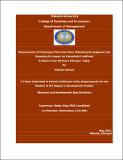| dc.description.abstract | This study aims at identifying determinants of choosing a particular dairy marketing
arrangement and assessing the impact of the arrangement to household livelihood. 387
households in four woredas of Tigray were administered through structured questionnaire.
Descriptive statistics and multinomial logit models were employed to determine the significance
of the factors affecting selection of a particular marketing arrangement. The three methods of
coordination implemented in the areas were spot, contracts and cooperative market, but
cooperative was dominantly exercised in the dairy chain. Propensity Score Matching was also
employed to examine the impact of marketing arrangements on household livelihood in terms of
asset formation, milk production and human capital. Free riding and lack of commitment were
the problems in cooperative marketing as indicated by focus group discussion. Long Fasting
dates and feed constraints have identified as a negative impact for milk selling and production in
the selected sites. Model results indicated that cooperative marketing arrangement in general,
provides higher prices, stable market, producing larger volume of milk and higher income to
producers than other marketing arrangements. Price volatility was high in spot marketing
arrangement as compared to contract and cooperative marketing. The results of this study
showed amount of milk production, price flexibility, active local administrative participation and
distance to main market significantly affecting the producer’s choice for cooperative marketing
in relative to spot and contract marketing arrangement. Among the three marketing
arrangements, contract marketing arrangement offered higher buyer access in the market.
Volume of milk production, price flexibility, distance to the main market and active local
administration participation were significant and positively related for the choice of cooperative
marketing arrangement. The model result also indicated vertical coordination was a mechanism for
enhancing producer’s livelihood in terms of asset accumulation and milk production for the market.
The study has a potential policy implication for improving dairy marketing arrangement and
livelihood of producers through promotion of large private investment in the area, which at the
end will introduce new technology in the sector such as improved cross breed cow, feed and
veterinary service. | en_GB |


